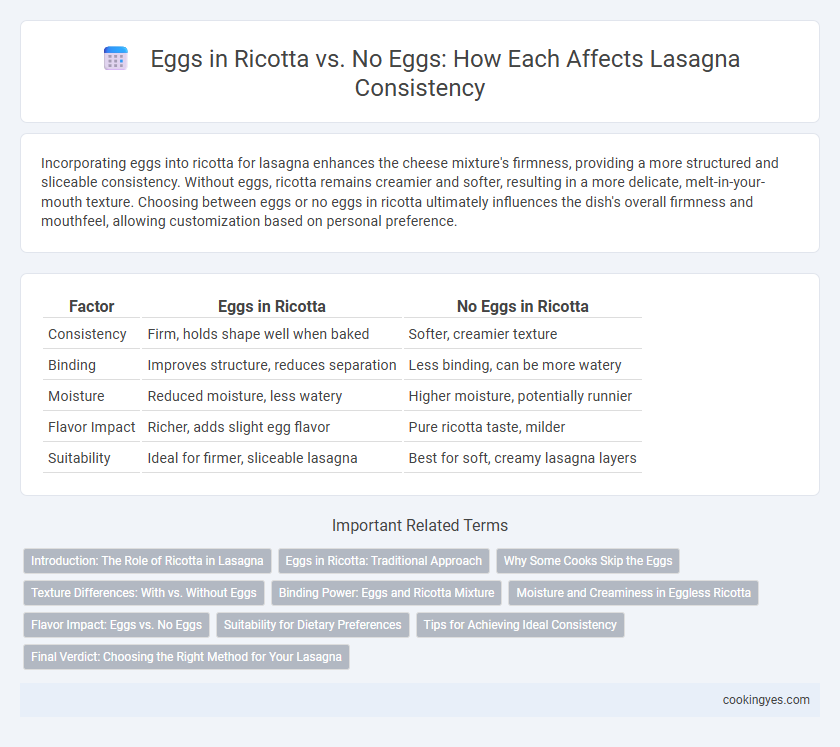Incorporating eggs into ricotta for lasagna enhances the cheese mixture's firmness, providing a more structured and sliceable consistency. Without eggs, ricotta remains creamier and softer, resulting in a more delicate, melt-in-your-mouth texture. Choosing between eggs or no eggs in ricotta ultimately influences the dish's overall firmness and mouthfeel, allowing customization based on personal preference.
Table of Comparison
| Factor | Eggs in Ricotta | No Eggs in Ricotta |
|---|---|---|
| Consistency | Firm, holds shape well when baked | Softer, creamier texture |
| Binding | Improves structure, reduces separation | Less binding, can be more watery |
| Moisture | Reduced moisture, less watery | Higher moisture, potentially runnier |
| Flavor Impact | Richer, adds slight egg flavor | Pure ricotta taste, milder |
| Suitability | Ideal for firmer, sliceable lasagna | Best for soft, creamy lasagna layers |
Introduction: The Role of Ricotta in Lasagna
Ricotta cheese plays a crucial role in lasagna by contributing creamy texture and moisture, with eggs often added to enhance firmness and prevent the filling from becoming too watery. Using eggs in ricotta results in a thicker, more structured layer that holds its shape during baking, while ricotta without eggs yields a lighter, softer consistency that blends more fluidly with other ingredients. The decision to include eggs in ricotta affects the overall texture and mouthfeel, influencing whether the lasagna has a dense, sliceable consistency or a delicate, melt-in-the-mouth experience.
Eggs in Ricotta: Traditional Approach
In traditional lasagna recipes, adding eggs to ricotta enhances the cheese mixture's firmness and stability, preventing it from becoming watery during baking. This technique helps achieve a creamy yet structured consistency that holds its shape when sliced. The protein in eggs acts as a binder, creating a richer texture essential for classic lasagna layers.
Why Some Cooks Skip the Eggs
Leaving eggs out of ricotta in lasagna results in a creamier, softer texture that blends more smoothly with tomato sauce and melted mozzarella. Many cooks skip eggs to prevent the filling from becoming too dense or rubbery, emphasizing a lighter, more delicate consistency. This choice also reduces cooking time since the ricotta does not need to set firmly, allowing for a luscious, melt-in-your-mouth layering experience.
Texture Differences: With vs. Without Eggs
Eggs in ricotta add a rich creaminess and help bind the cheese mixture, resulting in a firmer, more cohesive layer within lasagna. Without eggs, the ricotta remains lighter and slightly grainier, producing a softer, more delicate texture that allows other ingredients to stand out. The presence of eggs influences the overall mouthfeel, with egg-enriched ricotta contributing to a denser, more structured bite.
Binding Power: Eggs and Ricotta Mixture
Eggs in ricotta significantly enhance the binding power of the mixture, providing a firmer and more cohesive texture in lasagna layers. Ricotta without eggs tends to be lighter and creamier but may result in a looser consistency that can cause the lasagna to be less structurally stable when cut and served. The protein in eggs coagulates during baking, effectively helping the ricotta cheese to set and maintain the dish's shape.
Moisture and Creaminess in Eggless Ricotta
Eggs in ricotta provide structure and help set the cheese, resulting in a firmer lasagna texture, while eggless ricotta yields a softer, creamier consistency due to higher moisture retention. The absence of eggs allows the ricotta to remain more fluid, enhancing the overall creaminess but potentially making the lasagna less stable when sliced. Eggless ricotta is preferred for a moist, rich mouthfeel, especially in recipes emphasizing smooth, tender layers.
Flavor Impact: Eggs vs. No Eggs
Adding eggs to ricotta in lasagna enhances the custard-like texture and enriches the overall creaminess, creating a more cohesive layer that holds its shape during baking. Without eggs, ricotta remains lighter and more delicate, allowing the fresh, tangy flavor of the cheese to stand out more distinctly in each bite. The presence of eggs deepens the richness and contributes to a fuller mouthfeel, while omitting them keeps the dish brighter and less dense in flavor.
Suitability for Dietary Preferences
Using eggs in ricotta for lasagna enhances creaminess and firmness, making it ideal for traditional recipes seeking a rich texture, but may not suit vegan or egg-free diets. Ricotta without eggs offers a lighter, softer consistency, perfect for lactose-friendly or allergy-conscious diners who prefer dairy without added binders. Opting for egg-free ricotta accommodates diverse dietary preferences while maintaining a smooth, delicate filling in the lasagna layers.
Tips for Achieving Ideal Consistency
Incorporating eggs into ricotta cheese enhances the lasagna's structure by binding the layers more firmly, resulting in a creamier yet stable consistency that slices cleanly. Omitting eggs yields a lighter, softer texture that may cause the layers to spread or ooze slightly when cut, ideal for those preferring a delicate mouthfeel. To achieve ideal consistency, whisk eggs thoroughly into ricotta for uniform distribution or increase draining time of the cheese to reduce excess moisture when skipping eggs.
Final Verdict: Choosing the Right Method for Your Lasagna
Incorporating eggs into ricotta enhances the lasagna's consistency by providing a richer, creamier texture that holds its shape well during baking. Omitting eggs results in a lighter, slightly looser filling that may not firm up as much but offers a fresher, more delicate bite. Choosing between egg or no egg in ricotta depends on the desired lasagna texture--opt for eggs for structure and richness, or skip them for a softer, more traditional Italian-style lasagna.
Eggs in ricotta vs No eggs in ricotta for lasagna consistency Infographic

 cookingyes.com
cookingyes.com